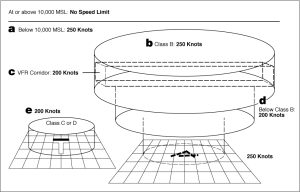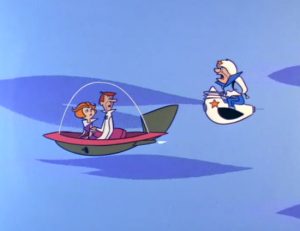I don’t know why I am even going to tempt Murphy’s Law, but I haven’t had a speeding ticket in many years. Of course now that I put it out there I can probably expect to get one on the way home this evening. The reason I even mention it (which I’m already regretting) is because today I want to discuss aircraft speed limits. This is essentially very similar to posted speed limits while driving, albeit don’t plan on seeing floating speed limit signs 10,000 feet in the air. This isn’t yet the Jetsons. Aircraft speed limits are outlined in 14 CFR §91.117 and is a regulation that needs to be memorized by the pilot.
Aircraft speed limits outlined in §91.117 have been established in the interest of safety. When we review the actual regulation below you will notice that speed limits tend to be lower in higher traffic or congested areas. Once again this is established for safety reasons, aircraft flying at slower airspeeds will have more time to react and prevent a possible midair collision.
§91.117 Aircraft speed.
(a) Unless otherwise authorized by the Administrator, no person may operate an aircraft below 10,000 feet MSL at an indicated airspeed of more than 250 knots (288 mph).
(b) Unless otherwise authorized or required by ATC, no person may operate an aircraft at or below 2,500 feet above the surface within 4 nautical miles of the primary airport of a Class C or Class D airspace area at an indicated airspeed of more than 200 knots (230 mph.). This paragraph (b) does not apply to any operations within a Class B airspace area. Such operations shall comply with paragraph (a) of this section.
(c) No person may operate an aircraft in the airspace underlying a Class B airspace area designated for an airport or in a VFR corridor designated through such a Class B airspace area, at an indicated airspeed of more than 200 knots (230 mph).
(d) If the minimum safe airspeed for any particular operation is greater than the maximum speed prescribed in this section, the aircraft may be operated at that minimum speed.
Ok, so we can breakdown this regulation into five essential aircraft speed limits, which you can see in the figure below by the corresponding letter (a through e).
- Below 10,000 feet MSL, the speed limit is 250 knots indicated air speed (KIAS). (See Figure, a)
- The speed limit within Class B airspace (See Figure, b) is also 250 KIAS.
- The maximum speed authorized in a VFR corridor through Class B airspace (See Figure, c) or in airspace underlying Class B airspace (See Figure, d) is 200 KIAS.
- In Class D airspace, aircraft are restricted to a maximum of 200 KIAS (See Figure, e).
- Unless otherwise authorized or required by ATC, no person may operate an aircraft at or below 2,500 feet AGL within 4 NM of the primary airport of a Class C or Class D airspace area at an indicated airspeed of more than 200 knots.
Notice the lower speed limits in higher traffic areas. There is one exception to this: in Class B airspace the aircraft speed limit is 250 knots. As I am sure you are aware, Class B is the busiest airspace. To understand why the limit is set much higher then C or D airspace you need to realize that Class B airspace is highly controlled airspace in which ATC provides traffic separation to all aircraft—from the Piper Cub to the B747, anyone passing through their airspace. Something else I am sure you noticed from the figure is the “No Speed Limit” above 10,000 ft. MSL. Wait did somebody say no speed limit!?!? Yep, sure did: airspace above 10,000 ft MSL is typically less congested and airspace above 18,000 ft. MSL is classified as Class A, which is controlled airspace and requires an IFR clearance and therefore traffic separation is provided by ATC.
You will be tested on this regulation in your initial training, but more than likely you will not be flying an aircraft that even has the capability to attain a speed over 200 knots. However, it is still important to get these aircraft speed limits drilled into your memory early on. Soon enough you will be behind the stick having to pull that throttle back to slow down, because hey you don’t want to get a ticket!






